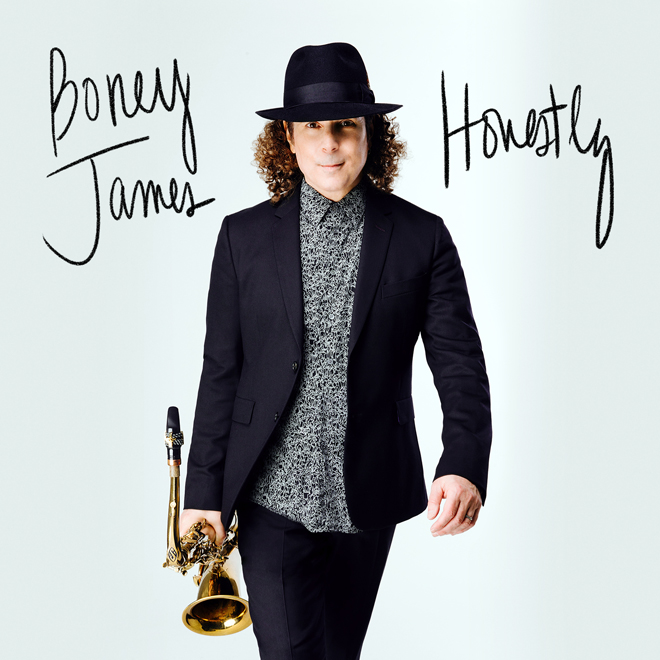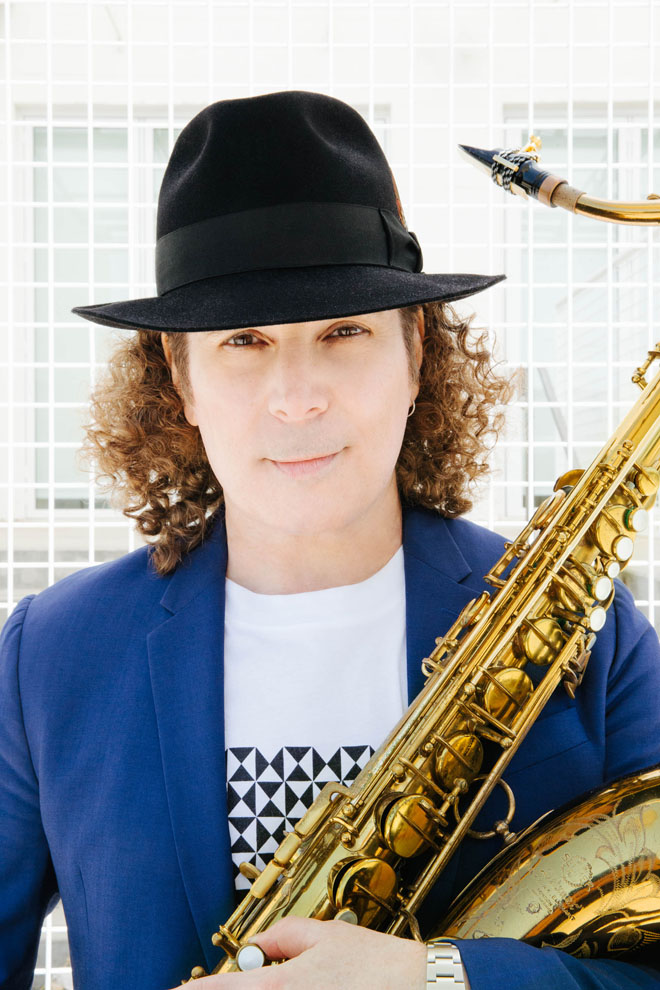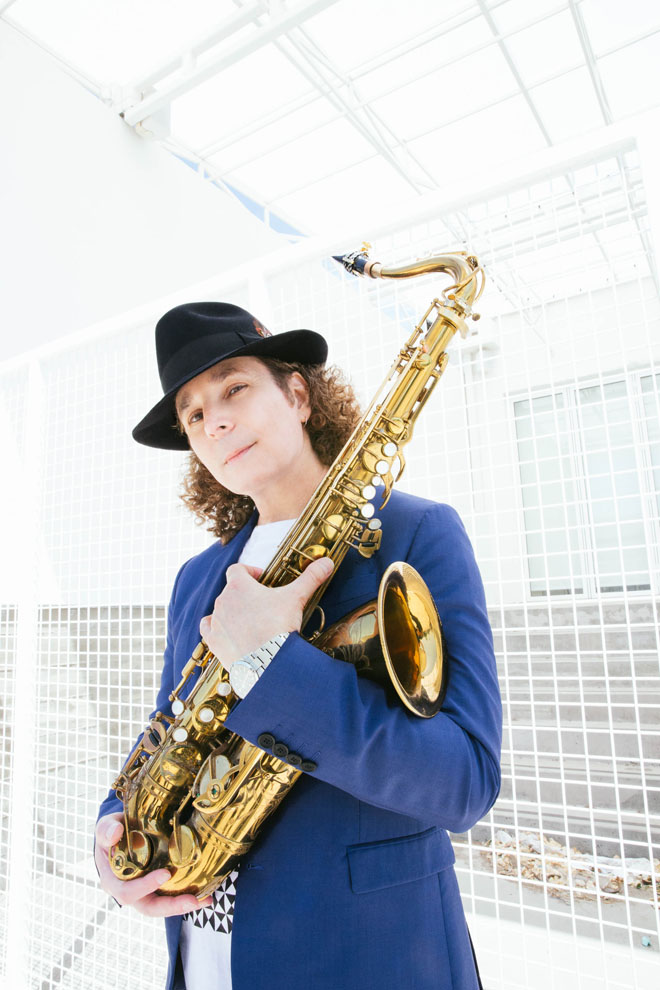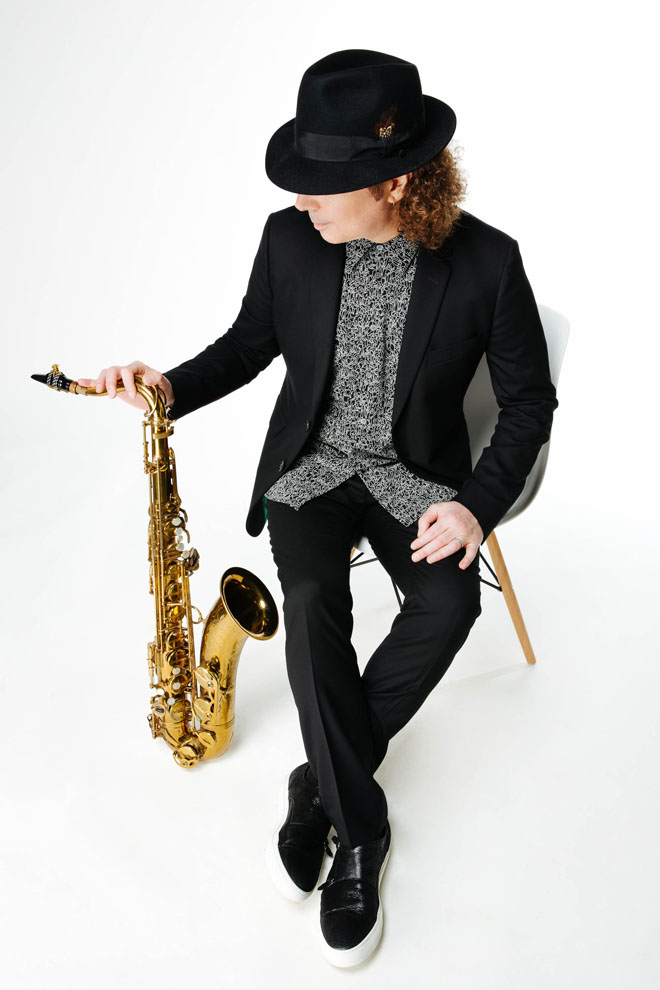VIDEO FEATURE & WEB-EXCLUSIVE INTERVIEW
Musician: BONEY JAMES
Video: “Honestly” featuring Avery*Sunshine
SAXOPHONIST AND COMPOSER BONEY JAMES’ HONESTLY REFLECTS MUSIC’S POWER TO TRANSPORT
Four-time Grammy Nominee Celebrates 25 Years with September 1, 2017 Release Featuring Vocalists Avery*Sunshine and Eric Roberson
Boney James released his 16th album on September 1, 2017, titled Honestly—25 years after his debut recording, Trust. This apparent direct line between those titles helps us understand what motivates the four-time Grammy nominee and multi-platinum-selling musician.
“I’m fighting the good fight to be my own artist and not be pigeonholed,” says the genre-blurring James. “With a record’s title I always try to find something that will communicate the feeling I get when I listen to it. The feeling I get with this music is a sense of sincerity and intimacy. The word ‘honestly’ really reflects how I aspire to live my life and create my music. One of the great things about music is how powerful it is. It can totally transport people. These are interesting times we are living in, and the one thing I can do with the skills that I have is to make music that evokes a feeling and takes people somewhere—to do what I can to try and make the world a more pleasant place.”
Honestly follows futuresoul, James’ 2015 release which spent eleven weeks at No. 1 on the Billboard Contemporary Jazz Chart. James produced the record and co-wrote all but one track, his interpretation of the Johnny Mercer-Hoagy Carmichael classic “Skylark.” He recruited collaborators and musicians whose work he admires, including chart-topping vocalists/co-writers Avery*Sunshine (“Honestly”) and Eric Roberson (“If I Can’t Hold You”).
James says, “The track Honestly (and first Urban Adult single) featuring Avery*Sunshine is straight up R&B.” Regarding Avery, James says, “I heard her at a festival, we were both playing and then I heard her No. 1 single “Call My Name” on the radio. I was instantly a fan and just waiting for the right song for us to collaborate.”
First instrumental single “Tick Tock,” one of four songs co-written and co-produced with Jairus Mozee (Anthony Hamilton, Robin Thicke) is one of several on the album featuring a horn arrangement by Jerry Hey, the incredibly talented Seawind trumpeter who worked with Michael Jackson, and has won Grammy awards for work with George Benson, Quincy Jones and Toto. “It’s a very funky track with an insistent groove and the arrangement goes places you don’t expect it to go,” says James.
Although each track on the album has its own definitive feel, James points directly toward some of his greatest influences as having provided inspiration. “I think about Stevie Wonder, Steely Dan and Earth, Wind & Fire,” he says, also mentioning such iconic R&B and contemporary jazz artists as the Brothers Johnson, Tower of Power and Grover Washington Jr. as having impacted him. “These are the bands that I grew up loving and the thing that they had was this method of arranging so the music is a character itself. That’s something I aspire to create on my records. The bass line can be a hook, or a horn line or keyboard riff that you sing in your head. That’s what I’m trying to create on the record—a tapestry of sounds that puts you in another world.”
James plays tenor and soprano saxophone parts on Honestly and contributes keyboards and drum programming to several of the tracks. But his career might have turned out a lot differently had a music store in his native New Rochelle, New York, had his first choice in stock the day he walked inside. “I wanted to play trumpet but when we went to the store to rent a trumpet all they had were clarinets, so I went home with a clarinet. Two years later I guess I was the best clarinet player in a band full of clarinets and the teacher wanted a sax player so he leaned on me to pick up the saxophone. I didn’t want to do it because it was a much heavier case I’d have to carry. But as soon as I switched I loved it and it pretty quickly became my favorite thing to do. It still is!”
By the time he entered his teens, James was gigging with bands, and he turned pro at 19. He apprenticed as a sideman for artists like Morris Day and the Isley Brothers, picking up pointers on how to present himself onstage and off, and didn’t cut his first album under his own name until he was 30. The independently released Trust immediately led to a major label deal and a string of increasingly successful recordings and live dates.
Over the years, James has racked up sales of more than three million records, four RIAA gold albums, four Grammy nominations, a Soul Train Award, nominations for two NAACP Image Awards and 10 CDs atop Billboard’s Contemporary Jazz Albums chart. In 2009, Billboard named him one of the Top 3 Contemporary Jazz Artists of the Decade along with Kenny G and Norah Jones.
With Honestly, as with futuresoul and the Grammy-nominated The Beat before it, Boney James is making some of the most stellar, wholly realized music of his career. “I’ve just grown up, personally and musically,” he says. “I’m a lot calmer now when I approach making music and have more confidence. I’m enjoying the process more now. I think that comes out in the music. Maybe that’s why this new record is so much fun to listen to. There are parts on the record that still make me smile.”
James spoke with us in Los Angeles, where he lives with his wife of 32 years, actress/director Lily Mariye, and has written scores for her film projects. Boney James tells us, “I was delivering pizzas to pay the bills—trying to figure out how to get into the business.” He later says, “I’ve had 25 years of thinking I’d have to go back to delivering pizzas.” When asked what advice he’d give to other musicians, he says, “There’s always going to be a struggle with a little frustration. But the actual trying to make a living making music is one of the great gifts available. So if you have the passion, just go for it and enjoy the trying to do it, regardless of what actually happens.”

Photo by Describe the Fauna
BONEY JAMES Interview with M Music & Musicians magazine publisher, Merlin David
How did the new album Honestly evolve?
It was pretty organic. I wasn’t planning on doing a new record so soon. Because the business has changed so much, I thought I’d take a little longer than my regular year-and-a-half or two years between records. I was still playing a lot of shows. The last record was futuresoul [2015] which was a very successful record. Somehow, the songs started flowing out. I stated collecting ideas, and I started to get excited about the ideas. My process is to sing little snippets into a memo recorder, or put a little thing down on a Pro Tools session. I collect enough until they start drawing me back to them. I open the files and work on them. The process started accelerating much faster than I thought it would. I looked up and I had almost a whole record done. I went to the label and said I’m working on this record, and they gave me my budget. At that point I was able to sit back and listen to the music to try and see if there was any theme that was popping up that was tying it all together.
Did you discover a theme for the record?
Themes happen all by themselves. It was during the US election, and there was a lot of strife in the world, but the music was happy and transporting. I was able to dive into the music as an alternative reality. That’s the interesting and powerful thing about music. It can stand for something positive regardless of what’s happening in the world. Almost around that time Avery*Sunshine wrote lyrics for the song “Honestly” and I thought that was a great word to encapsulate what I was hearing in the music. It was standing for something positive, and the word honestly stands for how I’m trying to live my life and how I’m trying to communicate my music. The theme of the record was positive energy.
How did working with Avery*Sunshine & Eric Roberson change your approach?
With Avery’s lyric for what became the title song, it encapsulated what I was already hearing on the record. The song that Eric wrote was a moody piece. He heard a sad pining for a lost love. It’s all transporting. It’s the power of music. Even songs that are moody, I hear beauty in them. It’s music standing for a constant good in the world.
How did the idea of “Tick Tock” come to you?
That’s a simple, happy, funky groove. The title suggested itself to me because the pocket is so insistent—it’s somewhat mechanical, even though it’s live drums playing to a sloppy loop. It had a certain back-and-forth quality that in my mind, I was seeing a clock. But the defining characteristic of that song is the horn section. And Jerry Hey, the tremendous arranger who worked on all the great Michael Jackson records and so many others—he and I did this arrangement together. That’s what takes the song to another level.

What did Jerry Hey’s horn arrangement bring to the song?
I always heard horns playing the chorus. And the middle section could be a trombone solo or something. Then I heard it as a throwback old-school Stax thing, but that’s not even Jerry’s forte. I sang him what I was hearing. But he takes my rudimentary melody idea, and brings all this harmony to it. The way he stacks the horns—he’s just a brilliant cat. We worked together going all the way back to 1994—on my third record when he and I first worked together. I’m grateful I’ve known him so long. I see him as one of the legends. He always brings this expensive sound to it. (Laughs) I have tremendous respect for him as a person and as a musician. Jerry, Bill Reichenbach and others are all A-Listers and they deserve that title.
Top 5 Musicians who inspired you to become a musician?
As soon as I picked up an axe, it was my favorite hobby right away. I was casting around for inspiration when I was young—10, 11, 12. When I was 13, I heard Grover Washington Jr. for the first time. Being a sax player, people always push you towards Coltrane and Charlie Parker. I really admire those guys as musicians, that music never floated my boat. I was always more into groove-oriented stuff. So when I heard Grover who was playing a wonderful-sounding tenor sax, alto and soprano sax with an incredible tone and a wonderful improvisational style—over an R&B pocket around 1974-75—that’s when I got really inspired by music. Then people like Ronnie Laws or the Crusaders and all that great music that was flowering in the 70s. With Stevie Wonder and Earth Wind & Fire on the R&B side incorporating great arrangements and instrument sections into their stuff—that whole era is what got me excited about music.
Do you consider yourself a music composer or a songwriter?
I consider myself a songwriter. When I listen to my music, I can hear a real style to the writing—even more so than the playing. I see myself as a singer trying to communicate these songs and melodies that I’ve written. That’s a big part of my self-identity.
Who inspired you to write songs?
Now that I’m 25 years into it, it’s hard to know how the inspiration ties into it. There are so many artists I admire: Steely Dan, Maurice White, Joni Mitchell, Paul Simon—people who were melodic, and people on the R&B side who you listened to the pocket or the harmonic sense. So many that it’s hard to name.
Tell me a little about your creative process for writing songs.
Memo recorder—opening files up.
What instrument/equipment can you not live without—that helps you write, record or perform?
My saxophone. (Laughs) My tenor and alto sax are both Selmer Mark VI—great vintage Mark VIs from the early 60s. My soprano sax is a Buescher. That’s a really vintage horn. I think it was late 20s when this horn was built. And since I was a kid, I’ve always played a Buescher. I use these Aaron Drake mouthpieces. It’s a new-ish mouthpiece maker. He designed a special one for my tenor, which he is now marketing as the Boney James Masters Series mouthpiece. I’m always looking for new stuff. I play these Silverstein ligatures which are pretty new. I’m always looking for the next new thing trying to improve my saxophone sound—changing reeds, changing all kinds of things. I’m never happy. (Laughs) But I still have the same Yamaha Motif ES8 keyboard that I’ve been writing on. I have lots of Soft Synths. I used the Spectrasonics Ominsphere and Keyscape a lot on this last record. I’m always looking for drum sounds. Lots of times I find loops and take pieces from what I’ve recorded and re-fashion into something new to try and sound current.

Photo by Describe the Fauna
Do you remember the first time you heard one of your songs on the radio?
I was in a writing session at a friend’s house. We were working on some new music, and just as we were chatting, the radio was on. And there it was—on KTWV in Los Angeles. It was when my first record Trust came out on Spindletop Records—that was on an Independent label. They didn’t have a big promotion muscle or anything. I had no expectations for that record at all, and there it was on the radio. I was just freaked out. And that record took off all by itself, and it put me on the map. And from there I was able to get signed to Warner Brothers. I made 10 records for WB, and had four Gold records. It was an incredible trajectory. I had really been butting my head against the wall trying to figure out how to get a record deal. I was working as a sideman, having the occasional day gig. They were tough times when I was younger. And all of a sudden, once people actually heard my music, it blew up.
Tell us about that journey?
I was delivering pizzas to pay the bills—trying to figure out how to get into the business. Then went to a cattle call for Morris Day in ’85, and got the gig playing keyboards for him. From that, I got another tour with Randy Crawford. I did that off and on for another five years. And then I did some Ray Parker Jr. shows. I worked with Teena Marie, and a couple of gigs with Sheena Easton. Then I got into the Isley Brothers for two years. I played with a pop singer named Martika—she had a big #1 smash. That gig accelerated my desire to be a solo artist. During that gig, I was the keyboard player and the sax player but very basic parts. I was on stage the whole time but I was just triggering background samples and playing the occasional string line, with a sax solo on only one song. I was not happy. It was months on the road feeling really frustrated with my life as a musician under those conditions. I thought, I just gotta do my own thing. That really kicked me in the butt to try harder to become a solo artist. And two years later I had my own record out. After that I started touring with Bobby Caldwell, and that was my last gig as a sideman—which was a great gig. His music was great, and I got to play my horn a lot. It was actually directly from that gig that I got signed. His front-of-the-house engineer was an aspiring record producer, and I was an aspiring artist. We got together and made what turned out to be my first record. Paul Brown produced my first three records, and I started co-producing after that, and we made another three records that way—produced by Boney James and Paul Brown. The first 10 years. And now it’s been 15 years that I’ve been producing records by myself.
What Performing Rights Organization are you with?
I’m with BMI. I don’t interact all that much with them. I’ve seen them get behind other writers, but there focus is definitely more on vocal material. I have a lot of titles. They should pay more attention to us. I’ve always felt a little like I was fighting a battle. First of all, whenever you hold a saxophone, everyone wants to think you’re a jazz musician. And the jazz critics as a while tend to look at a musician like me and sort of disavow me. I’m a little in no man’s land. And that’s OK. But I try to blur the genres and I try to be my own artist when I’m making my own music. That definitely makes it hard sometimes to promote yourself—people don’t know what to make of you.
What are your Top 5 favorite albums of all time? (Albums you wore out the grove)
Innervisions (1973) – Stevie Wonder
Heavy Weather (1977) – Weather Report
Gratitude (1975) – Earth, Wind & Fire
Sounds of Silence (1966) – Simon & Garfunkel
Greatest Hits (1976) – James Taylor
And any Steely Dan album.
Is there a “pinch me” moment—a time you recorded or played live on stage with someone you admired?
I don’t mean to sound cliché but I feel like that even now. I just got home from playing at the Chastain Park Amphitheater in Atlanta—a beautiful 6,000 seat place. George Benson and Regina Belle were on the bill. I’m playing my new music for the first time. Whenever I’m out there, looking at a crowd of people and they’re responding to what I’m doing—that a pinch-me moment, almost every night. It doesn’t ever get old. I’ve had some great milestones: my first gold record, Grammy nominations (now I’ve had four of those). People are noticing what I’m doing. I’m amazed by it all the time. I’ve had 25 years of thinking I’d have to go back to delivering pizzas. (Laughs)

Photo by Describe the Fauna
When did you first meet Al Jarreau?
I did the arrangement of the tracks by myself. They called me and asked me to do it, and I had worked with Al a couple of times. He sang on my 1997 Sweet Thing record. He and I had worked together, and we did a package tour together. We had spent a few months on a bus together. I knew Al, but I was super-honored when they asked me to some tracks. I guess he had heard the song on The Beat [2013] cd that I did with Raheem Devaughn. It made a little noise on R&B radio.
Must have been amazing to be called into work with Al.
I think he liked having someone like me who understood his jazzier side, but bring some R&B element to it. I think they wanted to do an R&B-inflected version of one of George Duke’s more jazzier songs. I did the arrangement of the track, and then I went into the studio with Al and recorded his vocal. And, of course, he brings his whole thing to it. He was super-creative. I took what he did back to my studio. Then, when we were mixing, he was super-involved too.
What was it like to work with Al Jarreau?
When I was 13 or 14, Look to the Rainbow came out, and I fell in love—big impression on a young musician like me. Fast forward 10-13 years later, when I was an artist, and to have someone like Al know who I was and agree to collaborate with me, and then another 10 years later to produce him. It’s hard to even express how that feels. I always saw him as this mythic figure. But in person he was very warm, charming and funny, and a very artistic person. I truly treasure the time I spent with him.
What’s the best advice you’ve been given re: your music or music career?
My sax teacher, Bill Green, always told me: music, in general, is a lifetime study, never start to think that you got it done—that’s when you’re going to slide backwards. That’s something I remember all the time. It keeps me practicing every day.
Best advice you’d like to give upcoming musicians?
If you love it, and this is the only thing you can do—then that’s a beautiful thing. Don’t be reaching for the pot of gold at the end of the rainbow. It really doesn’t exist. There’s never a point where you can sit back and say you’ve “arrived” and made it. There’s always going to be a struggle with a little frustration. But the actual trying to make a living making music is one of the great gifts available. So if you have the passion, just go for it and enjoy the trying to do it, regardless of what actually happens.
What’s next?
The record was released September 1, and I’m trying to get the word out about that as much as I can. We’ve got a big tour coming up with lots of shows. We’ve been playing our first shows with new music in it, and we’re real excited about that—getting out there and spread the word one city at a time about this new record that I’m so proud of.
Where can your new fans get more info and stay updated?
BoneyJames.com

Photo by Describe the Fauna



comment closed